How Often Do I Have To Clean My Fish Tank
When people find out you keep fish, they probably imagine a crusty, algae-coated tank where you can barely see annihilation swimming within. But with just a few easy steps, you can go along your aquarium looking like a beautiful work of art. Follow along every bit we share our elevation tips for cleaning your fish tank like a pro.
Before You Go Started…
There are several frequently answered questions we often hear from beginners, then let's address those first:
How frequently do you need to clean a fish tank?
Some people say in one case a week, while others say once a month. The real reply is that it totally depends! Several factors include the size of your tank, how many fish you keep, and how much biological filtration (e.yard., beneficial bacteria and alive plants) yous accept. Fortunately, we have a gratuitous guide to assist you figure out exactly what frequency is right for your aquarium.
Do you take the fish out of the tank when cleaning?
No, go ahead and leave your fish in the aquarium. You won't exist completely draining the aquarium, so there will exist plenty of water left for them to swim in. Also, the process of catching them is more stressful for the fish than slowly cleaning around them.
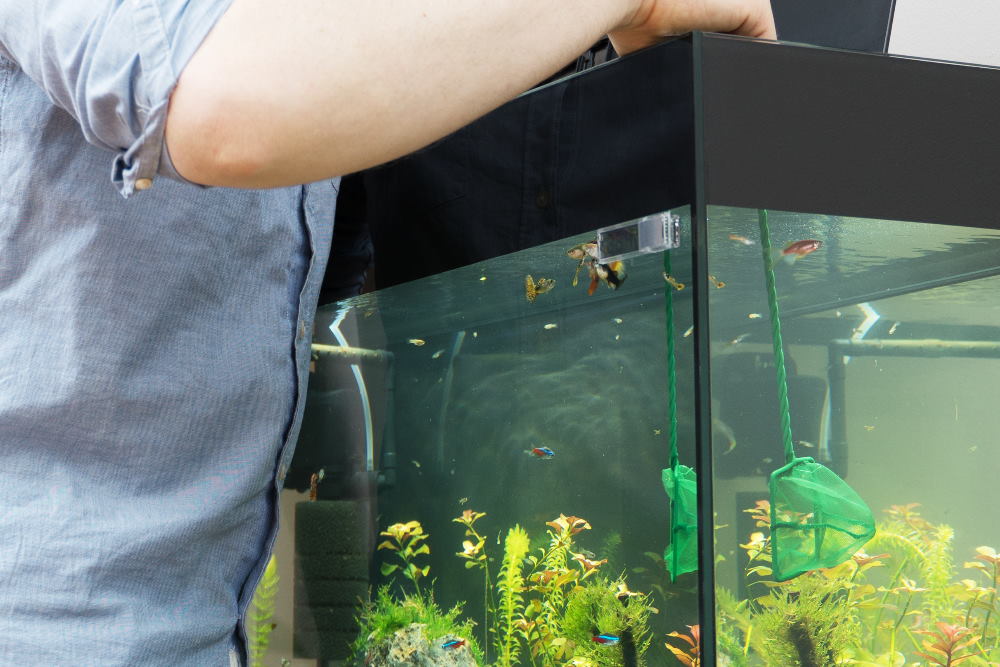
In that location'south no need to catch the fish before cleaning an aquarium because it will merely crusade undue stress.
How long practice you allow water sit before putting fish in?
This former school piece of advice comes from the fact that municipalities oftentimes put chlorine in tap h2o (which is lethal to fish), only if you let the h2o sit out for 24 hours, the chlorine evaporates. Nowadays, chloramine (a more than stable form of chlorine) is frequently used in tap water, and it does not evaporate over fourth dimension. Instead, you need to dose water conditioner to make the water safe for fish, and and so you tin can immediately use the dechlorinated water for your aquarium with no expect fourth dimension.
What cleaning supplies do you need to get?
If this is your first aquarium, yous may need to collect some tank maintenance materials, such equally:
- Aquarium water examination kit
- Bucket for holding muddy tank water
- Algae scraper (for glass or acrylic)
- Algae scraper blade attachment (for glass or acrylic)
- Toothbrush for cleaning algae off decor or plants
- Pair of scissors for pruning plants
- Dechlorinator (also known equally h2o conditioner)
- Glass cleaner
- Towel for wiping upward water spills
- Glass-cleaning cloth or newspaper towel
- Aquarium siphon (besides known every bit a gravel vacuum)
(As an Amazon Associate, nosotros earn from qualifying purchases, and commissions may be earned from the link higher up.)
How to Clean Your Aquarium
Now that we've cleared upwards some defoliation about tank maintenance, here is a step-by-pace guide for you lot to follow on a regular ground:
Step ane: Test the Water Quality
If your aquarium is newly established and has not been cycled yet, y'all need to examination the water to determine if it has 0 ppm ammonia, 0 ppm nitrites, and less than xl ppm nitrates. (For more info, find out how to wheel your aquarium.) Higher levels of these waste matter compounds can be dangerous for fish.
If your aquarium is already cycled, then the goal is to continue nitrate levels below forty ppm. Measure the nitrates using a water test kit to determine how much h2o should be removed and if other steps need to be taken (based on our costless guide to water changes).

A water test kit helps you determine if in that location are toxic levels of nitrogen waste matter compounds in the aquarium.
Step 2: Remove Algae
In order to maintain a articulate view of our fish, scrub the tank walls with an algae scraper. If you take the blade zipper, it should be very easy to slice through any tough algae spots. Just brand sure not to catch any substrate underneath the algae scraper, or you may stop up scratching the glass or acrylic.
If algae has grown on the chapeau, you lot tin can easily rinse it off in the sink. (Don't use soap or it may damage your fish.) Finally, if algae covers your aquarium decor, rocks, or plants, try using a clean toothbrush to gently castor information technology off, either over the sink or in the aquarium. Read our article on how to become rid of algae for more tips and tricks.
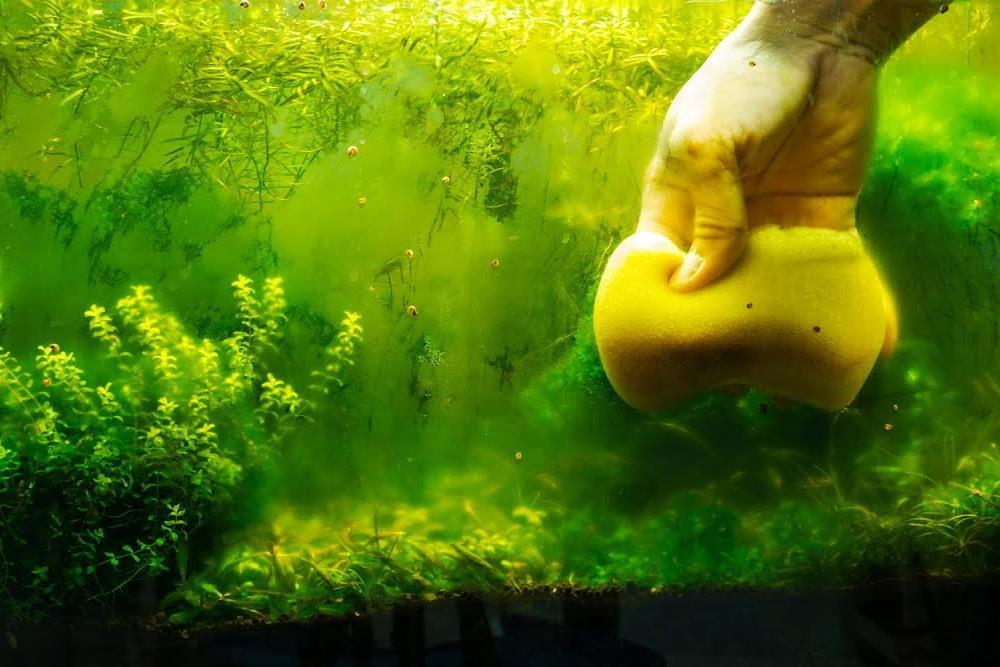
Go on algae under control past regularly removing it and balancing the lighting and nutrient levels in your aquarium.
Step 3: Prune the Plants
If you keep live aquarium plants, have this time to remove any dead leaves and trim down overgrown leafage. If you lot have tall stem plants, you tin easily propagate them by cutting a few inches off the tops and replanting them into the substrate. If your vallisneria or dwarf sagittaria are spreading into unwanted areas, pull out the lilliputian runners and move them elsewhere. Lastly, if floating plants have completely covered the unabridged water surface, remove nearly xxx% to l% of them so that the plants beneath become enough calorie-free and the fish get enough oxygen.
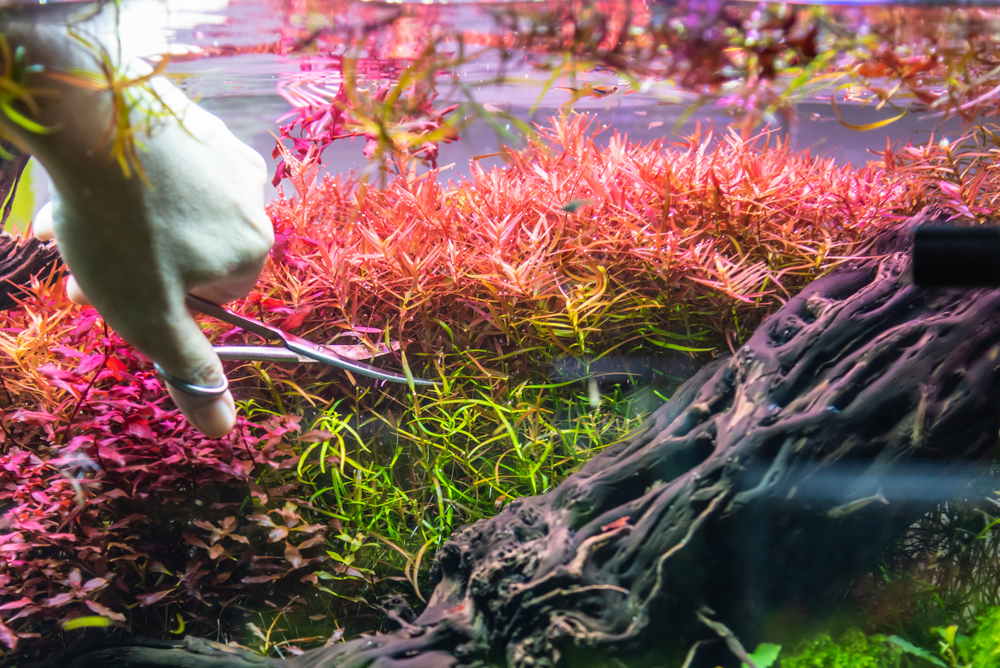
Pruning helps plants to focus on delivering nutrients to the healthiest leaves, and it as well allows calorie-free to reach leaves at the bottom of the stems.
Step 4: Turn off Equipment
Earlier removing any water, brand certain to turn off or unplug all equipment. Aquarium heaters and filters are not meant to operate without water and therefore can get damaged when running in dry out air.
Step 5: Vacuum the Substrate
Take out your cracking aquarium siphon and vacuum approximately one-third of the substrate. Move whatever decorations or hardscape as needed, since debris tends to collect underneath them. The siphon serves the dual purpose of not just removing fish waste product, uneaten nutrient, and dead leaves from the gravel or sand, only also removing sometime tank water and the excess nitrates in them. Check out our gravel vacuum article for detailed instructions on how to start a siphon (and how to cease it if you lot accidentally suck up a small fish).
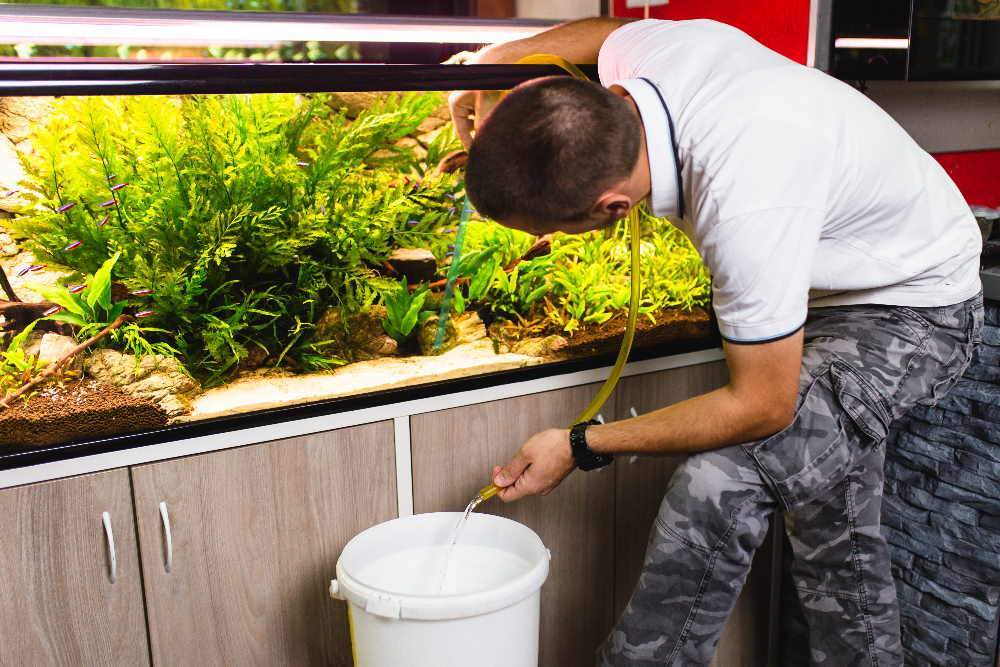
Siphons are one of the most useful tools for easily changing water without having to use a cup or pitcher.
Step 6: Make clean the Filter
At to the lowest degree once a month, y'all should make clean the filter. Many beginners recall of filters like a black pigsty where fish poop and detritus magically disappear from the water. In reality, filters are more than similar trash cans that collect waste material, merely at the end of the day, someone is nonetheless responsible for taking out the trash can. In the same way, filters collect fish waste, but you must nonetheless regularly clean it to remove all the gunk before the filter gets chock-full up or overflows.
If you have a hang-on-dorsum, canister, or corner box filter, the easiest mode to maintenance information technology is to swish around and launder the filter media in your saucepan of recently removed tank water. (Again, practise not utilize lather, only water.) If you accept a sponge filter, remove the cream portion and wring it multiple times in the bucket of old tank h2o. For more details, read the terminal department of our sponge filter article.
Step vii: Refill the H2o
At this signal, you can finally refill the tank with fresh, clean water that matches the temperature of the existing aquarium water. Human hands are able to observe temperatures inside i or two degrees, then just adjust the faucet until the tap water feels similar it has the same amount of warmth. Empty out the bucket of old tank water (which tin be used to feed indoor and outdoor plants), and refill information technology with tap water. You can either add dechlorinator into the bucket (dosed based on the bucket's book) or directly into the tank (dosed based on the aquarium's volume). This is too your chance to add liquid fertilizer and/or root tabs for the substrate.
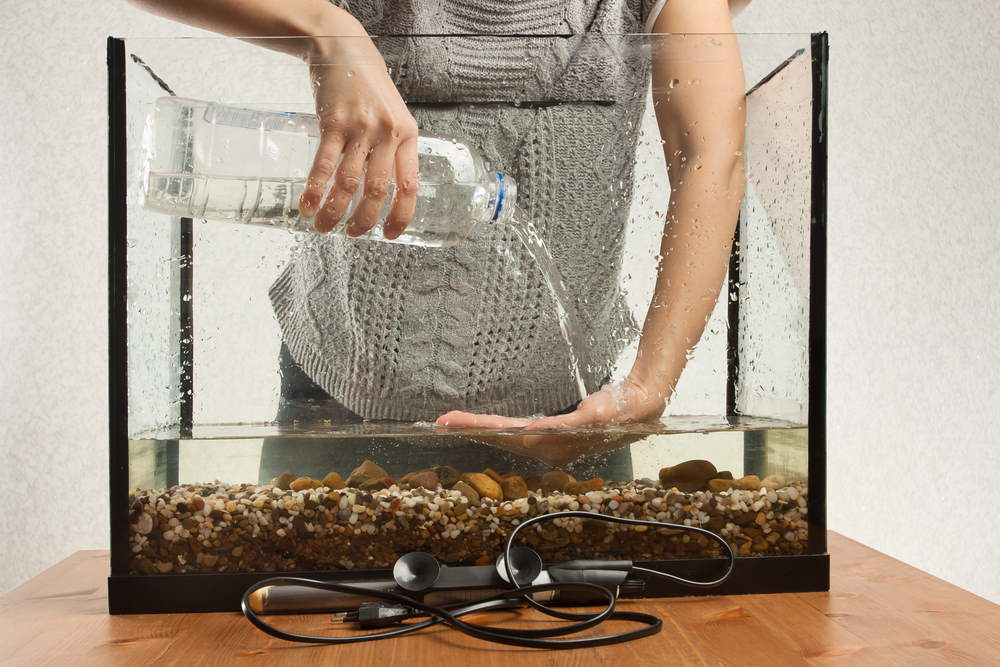
If you're worried about messing up your aquascape or substrate, pour the new water into the aquarium through a colander or onto another solid surface (similar your hand or a plastic pocketbook) to lessen any disturbances.
Step 8: Turn on Equipment
Although you just spent all this time cleaning the tank, it probably looks dirtier than ever with all that particulate clouding up the water. Non to worry – plow on the heater and filter again, and within an hour or so, the debris will settle down or get sucked upward by the filter.
Step 9: Wipe the Glass
For that actress, crystal-clear terminate, wipe down the exterior walls of the tank with aquarium-rubber glass and acrylic cleaner to remove any water spots and smudges. Too, clean off the dust that has collected on the lid, light, and aquarium stand. Now yous have a truly Instagram-worthy aquarium ready to wow your friends and family!
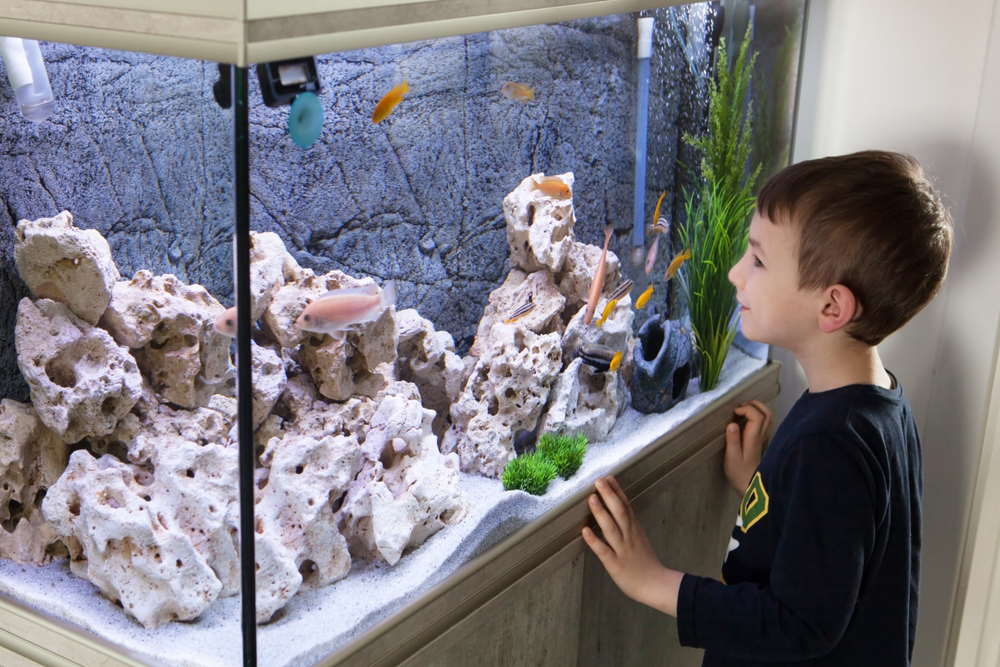
Bask the fruits of your labor past spending hours staring at your happy and salubrious fish.
Source: https://www.aquariumcoop.com/blogs/aquarium/aquarium-cleaning
Posted by: fosterwhippyraton.blogspot.com


0 Response to "How Often Do I Have To Clean My Fish Tank"
Post a Comment